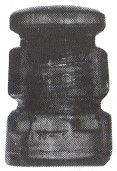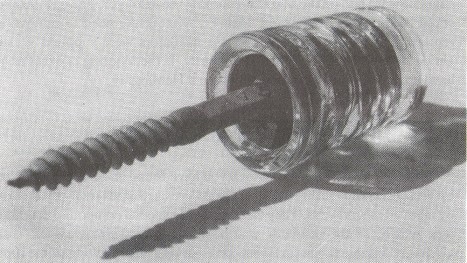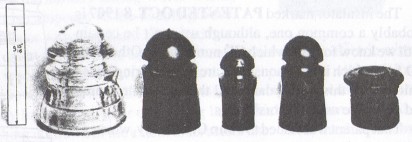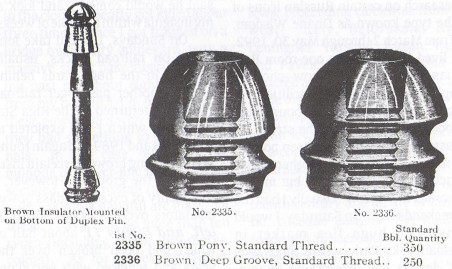Ask Woody
by N. R. Woodward
Reprinted from "Crown Jewels of the Wire", December 1992, page 8
N. R. "Woody" Woodward is the author of THE GLASS INSULATOR IN
AMERICA, 1988 Report and developed
the Consolidated Design Numbers identification system for glass insulators.
The first question was submitted by Ken House of Deltona, Florida.
QUESTION: I am sending a photo of an insulator that came out of a collection
from North Carolina. It measures 2-1/4" high and slightly over 1-1/2"
in diameter at the base. Would you help me identify this small insulator and its
use?

The IN-56 insulator was made by Owens-Illinois for the military during World
War II years. It is
composed of the double groove
glass insulator with a lag screw cemented into the pin cavity. It served to
string telephone or low voltage electric wires on any wooden support, without
regard to the particular style of line construction in the area. Thus it was
suitable for speedy construction of temporary lines or for repair of existing
lines which had been damaged.
Nothing is known of the extent of its actual use.
These insulators came to the attention of the public when numbers of them
appeared on the military surplus market during the 1950s. They were used by
farmers for electric fences or rural phone lines.
Although it has a threaded
pinhole, the IN-56 is not properly a pin-type insulator since it was intended
for use only with the lag screw cemented in place. Since a metallic cement with
a low melting point was used, some of these have been removed from the lag screw
and give the appearance of a small pin-type insulator.
There is also a
similar insulator made from brown glazed porcelain. These seem to be somewhat
less common than the glass ones. Perhaps some of our porcelain people know who
made those?

Ken House's IN-56 had the lag screw removed. Above is how the
complete
insulator was assembled for affixing to any wood surface.
The following questions are from Gary Short of Chapmansboro, TN.
QUESTION: I have a beehive style insulator which has large threads on the
outside of the glass. It is marked "Patented Oct. 8, 1907". I am not familiar
with its patent.
The insulator marked PATENTED OCT. 8 1907 is probably a common one, although
we can't be certain until we know for sure which CD number it is. Other than CD
147, which is common, there are two differing styles which carry this patent
date; and they are quite scarce and desirable as collectors' items.
That patent
was issued to John C. Barclay, who was chief engineer at Western Union during
those years. These insulators were designed for use with the heavy iron wire
that was standard on telegraph lines prior to World War I. On those lines, the
tie wire consisted of a single U-shaped loop which was twisted one and one-half
turns around the line wire on either side of the insulator.
As you will note,
the external thread runs opposite to the internal one. The theory was that as a
damaged insulator was removed from the pin for replacement, it could be
simultaneously removed from the wire by a slight upward pull on the line while turning the insulator. The new insulator
could be installed in the same manner, without the need to remove and replace
the tie wire. Millions of these insulators were supplied Western Union by both
Brookfield and Hemingray. If the lettering is exact as you have copied it, your
specimen would be a Hemingray.
QUESTION: Also I have a rubber insulator embossed with Continental Rubber
Works, Erie, PA. USA plus a patent number. Is it uncommon?
The rubber insulators, of which you have found an R-4, were designed by
Western Union during the 1930s and were used extensively by them and by many of
the railways. They were made of a special compound containing wax which, as the
insulator was heated during warm weather, would gradually migrate to the surface
to avoid drying and cracking of the rubber and maintaining a good insulating
surface. These insulators did not have an unlimited life. If yours is quite old,
the surface may be dry and checked, indicating the insulator had outlived its
best years. Also, surprisingly, in some parts of the country squirrels found
them appetizing; and in wooded areas one may find, rubber insulators partially
eaten away.
The rubber insulators were primarily intended for use in areas where
vandalism was high and breakage of glass occurred on a regular basis. It was
understood that they did not have the unlimited life span of a glass insulator.
|

Figure 2. Left to right:
Standard double petticoat glass insulator;
R-4 Rubber insulator for use on
wood pin;
R-3 Rubber insulator for mounting on spindle of steel pin;
R-5 Rubber
insulator for use on telephone-type short shank transposition pin;
RC-1 Rubber
insulator for use with Case span-type transposition bracket.
Illustration from Western Union Technical Review for April, 1949
|
QUESTION: The last insulator I have is one with a hole through it. It is 2-1/2
inches tall, 2-7/8" wide, the wire groove is 3/8" deep by 5/8"
wide. The pinhole is threaded for a 1" pin.
The third insulator you described was made under the Robert G. Brown
patent of November 23, 1886. There were two styles made, the Brown Pony (CD 187)
and the Brown Deep Groove (CD 188). According to the measurements you gave, you
have a specimen of the latter, the less common of the two. These were made for
use with a special pin, the upper part of which was the same as a regular pin;
but the lower part extended below the bottom of the crossarm and was also
threaded. The Brown insulator was used thereon. When an arm was assembled with
Brown pins, its capacity for wires was doubled.
The reason for the through
pinhole is so that if water gets into the insulator it can drain through and not
remain inside the threads. Should that happen, the insulator will crack if the
temperature drops below freezing. The top of the insulator was rounded to shed
water and was supposed to fit closely under the crossarm, But the open bottom
was a double safeguard.
Most of these are embossed PAT'D NOV. 23d 1886. Often
they are difficult to read; but check your sample for this marking.

A page from Edwin C. Lewis Catalogue, c1908,
showing Browns with an assembled
Brown pin.
| 